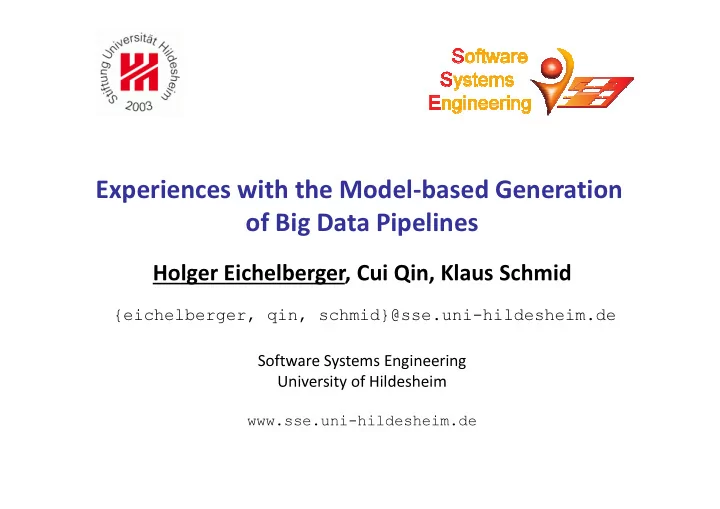

Experiences with the Model-based Generation of Big Data Pipelines Holger Eichelberger, Cui Qin, Klaus Schmid {eichelberger, qin, schmid}@sse.uni-hildesheim.de Software Systems Engineering University of Hildesheim www.sse.uni-hildesheim.de
Motivation • Background FP7 QualiMaster: – Configurable and adaptive data processing infrastructure – Real-time financial risk analysis • Programming applications for Big Data frameworks is complex • Ideal: Focus on data processing, ignore technical complexity • Goal: – Model-based approach to stream processing – Hide complexity Experiences – Ease development Lessons learned – Generate complex parts of code – Support self-adaptation 3/6/2017 1 Experiences with the Model-based Generation of Big Data Pipelines
Model-based design • Basis: Concept analysis – Fixed stream operators (e.g., Borealis, PIPES) – User-defined operators / algorithms (e.g., Storm, Heron) – Combinations (e.g., Spark, Flink) • Common concept: Data flow graph Common concept: Data flow graph • Typically represented as program • Recent trend: DSL Data source Data processors Data sink P1 P2 P3 3/6/2017 2 Experiences with the Model-based Generation of Big Data Pipelines
Specific modeling concepts Data processing pipeline P1 P2 P3 Algorithm family Sink Source P2.1 P2.1 P2.1 P2.1 Hardware co- Simple algorithm Sub-pipeline processor • Domain restrictions – Must be a valid data flow graph – If P s → P e , P s must provide types that P e can process – Interface compatibility between families and algorithms 3/6/2017 3 Experiences with the Model-based Generation of Big Data Pipelines
Modeling support Underlying: Own model- managment framework Domain-specific modeling frontend 5 3/6/2017 Experiences with the Model-based Generation of Big Data Pipelines
Code generation Generated Pipelines / • Architecture Applications Management Stack – Heterogeneous resource pool Intermediary Layer – Intermediary layer extending Storm Stream Processing Framework Reconfigurable – Management layer (Apache Storm) Hardware for runtime • Generation steps – Family interfaces 16 pipelines – Data serialization support • x 7 code produced – Integration of hardware co-processors • ~880 MB deployable components – Pipelines / sub-pipelines, switching – Compile, integrate dependencies, package 6 3/6/2017 Experiences with the Model-based Generation of Big Data Pipelines
Experiences and Lessons learned (1) • 7 data engineers from 3 groups, 6 large pipelines • Beginning of the project – Sceptical about model-based approach – Initial version after some months – Hands-on workshops – Feedback: – Feedback: • Puzzled about type saftey • First own generated pipelines helped • Change of focus: More on algorithms • Requests for new features, reports on buggy features • Confidence increased with improved versions (~1 year) 7 3/6/2017 Experiences with the Model-based Generation of Big Data Pipelines
Experiences and Lessons learned (2) • Later phases – Interfaces help to structure work – Typing helps avoiding runtime errors – “Magic“ of generated code • serialization • parameters • algorithm switching – Complex structures due to additional nodes, communication – For sub-pipelines: Manual / generated code perform the same – Shields from complex coding 8 3/6/2017 Experiences with the Model-based Generation of Big Data Pipelines
Experiences and Lessons learned (2) • Center of integration → Higher workload • Supports evolution – Consistent deployment of changes – Algorithms must be evolved manually – Also errors are deployed easily • Continuous integration – Generation and algorithms – Up-to date pipelines are available – Intensive tests increase overall build time → local debugging first • Effects – Focus of work on algorithms – Allows realization and evolution of complex structures – Avoid runtime issues – Stability increases confidence, requires higher quality assurance 9 3/6/2017 Experiences with the Model-based Generation of Big Data Pipelines
Conclusions • Model-based approach for streaming Big Data applications – Type-safe – Heterogeneous data processing (hardware co-processors) – Flexible exchange of algorithms • Code generation for Apache Storm • Approach pays off • Approach pays off – Positive feedback – Requires training, modeling effort, effort for realization of transformation, maintenance and evolution • Future: Optimized code generation for self-adaptation – Switching efficiency Optimized resource usage is already reality! – Multiple target platforms 10 3/6/2017 Experiences with the Model-based Generation of Big Data Pipelines
Recommend
More recommend